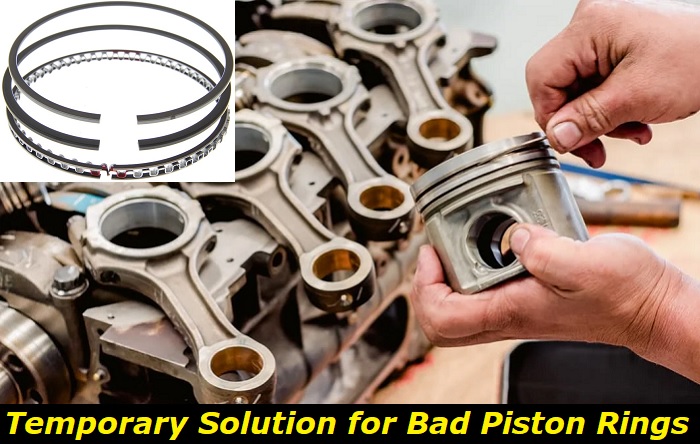What is a piston ring? What are its functions, and what would happen if it failed? Such are the questions that motor vehicle owners are left asking themselves when the mechanic declares that piston rings are the problem with the car.
Engine leaks highlights
- Level of importance:Medium
- Commonreasons:Problems with seals and gaskets, internal failures
- DIY inspection:Possible but complicated
- DIY repair:Mostly,impossible
- Price for repair:$150 - $650
- Can you drive?Only if the leak is minor
- Ways to fix:Replace the broken gasket or seal, replace the failed part

How do piston rings get damaged?
The engine is a critical car part you do not want a quack near. It would be best if you were certain that the engine has a problem or, in our case, the piston rings before disassembling the engine. Once disassembled, the engine is seldom reassembled to its original setting. Here are some of the symptoms that will help you know if the piston rings are in trouble:
- Blue exhaust smoke - The bluish smoke from the exhaust means oil leaks into the combustion chamber and gets burned with the fuel mixture.
- Reduced car efficiency - You will notice a sudden power reduction and increased fuel consumption. The rings cannot seal the chamber properly, and combustion gases are not powered to the crankshaft hence a car's reduced power.
- The engine runs roughly - This includes backfires, misfires, rough idling, and poor acceleration.
- Engine oil runs out fast - The middle ring scrapes the oil from the piston sleeve back into the sump. When you notice oil disappearing fast, it may be that the rings are not scraping properly, leading to oil mixing with the fuel mixture in the combustion chamber.
- Oil leaks - If you notice oil leaks from different engine points, you likely have a piston ring problem. With faulty rings, the pressure inside the crankcase will be immense hence the oil leaks.
What causes piston ring damage?
Like any car part, piston rings can get damaged or wear out due to usage. The continued movement of the rings can lead to them getting cracked or scored. The leading reasons for this can be:
- Exposure to too much heat
- Exposure to excessing pressure
- Failure to maintain the engine properly
How to fix a bad piston ring
As pointed out earlier, the optimal running of an engine highly depends on the state of the piston rings. The cost of piston rings is low but the labor and the time involved in replacing them make them expensive. Depending on your car's make and model, the rings' cost should be between $50 and $200. However, the labor cost can be between $1,000 and $5,000 depending on your car's make and model.
As a car owner, you don't want to be dishing out $5k every few months to repair your car's piston rings. For this reason, most professional mechanics advise replacing bad piston rings rather than trying to repair them. Because the rings are found deep inside the engine, total engine disassembly is necessary, and an expert in the field is required.
The actual process of fixing your piston rings sometimes even requires the total engine removal. This is because you should remove the head and clean the engine block after the engine has been reassembled. Don't forget you should also remove the oil sump to access some engine components. Though possible, it would be quite messy trying to replace piston rings while the engine is in the car.
Piston rings ideally last the whole life of your car. Unless done wrong, replaced piston rings should last the rest of the car's life. Therefore, it doesn't make much sense to try and repair the rings considering the labor cost for repair and replacement is astronomical.
It is highly recommended that you stop driving your car once you discover it has a piston ring problem. Continued car use leads to more damage to the piston head, the arm, and the engine block. A damaged engine block has no sure repair, and a replacement of the entire block will be necessary.
Is there a temporary fix for bad piston rings?
There are several suggested tricks that you can employ to sort the piston ring problem.
1) Use of Seafoam
Some mechanics recommend pouring sea foam into the piston chamber to repair faulty rings. One is supposed to remove the plugs and pour a good burst of sea foam into the engine. Seafoam is allowed to settle for about three days before you notice a significant improvement in the performance of the piston.
Seafoam is an oil product that is said to re-liquefy gum and sludge, remove hard carbon parts in the engine, and remove them from the system. In our case, it is used to sort stuck piston rings.
Many car experts profess the effectiveness of sea foam, but some totally disagree with this. Even though sea foam has been seen to help unstuck piston rings in the short run, in the long run, it is said to create more problems for the car owner. Here are some of the issues:
- It is not compatible with some injector systems
- It may thin out the oil hence risking the engine
- It may destroy the O2 sensor
- At times it has been seen to create more sludge than removing it
- Fuel efficiency may deteriorate
2) Use of vinegar, brake cleaner, and penetrating oil
This process requires that you remove the plug from its port. You should then remove grime and sludge from the piston sleeve. Pour some vinegar, penetrating oil, and brake cleaner until the piston is covered and leave it for some days or until the rings are fully soaked.
This strategy doesn't require the disassembly of the engine, and you can do it at home. While this method aims to get stuck piston rings to work again, it works as a first aid option. Cracked or worn rings will not be repaired using this method. This method is likely only to give you superficial results, whereas the piston rings, the engine block, or the pistons continue getting damaged irreparably.
Conclusion
Just as it is with the human body, taking a painkiller helps the body deal with pain but not treating the underlying condition. In the case of the piston rings, some of the temporary solutions suggested and said to have been used by mechanics and drivers for decades are not as effective as advertised. It would serve as self-sabotage if you poured a liquid into your engine only to realize that it makes the oil less viscous hence losing the ability to lubricate.
Though expensive, the surest way to solve the piston rings problem is to dissemble the engine and physically assess the rings, pistons, head cylinder, sleeve, and engine block. This way, you will see whether a piston has seized or the problem was actually with the rings. Once you expertly reassemble the engine with new rings, this problem is unlikely to reappear for the rest of the car's lifespan.
About the authors
The CarAraC research team is composed of seasoned auto mechanics and automotive industry professionals, including individuals with advanced degrees and certifications in their field. Our team members boast prestigious credentials, reflecting their extensive knowledge and skills. These qualifications include: IMI: Institute of the Motor Industry, ASE-Certified Master Automobile Technicians; Coventry University, Graduate of MA in Automotive Journalism; Politecnico di Torino, Italy, MS Automotive Engineering; Ss. Cyril and Methodius University in Skopje, Mechanical University in Skopje; TOC Automotive College; DHA Suffa University, Department of Mechanical Engineering






Add comment